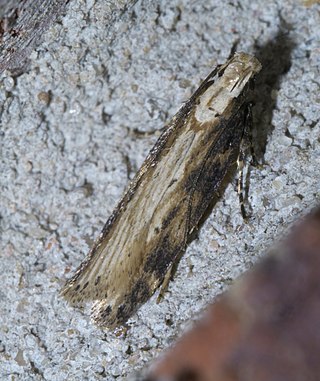
The setaceous Hebrew character is a moth of the family Noctuidae. The species was first described by Carl Linnaeus in his 1758 10th edition of Systema Naturae. It is found in the Palearctic realm. It is a common species throughout Europe and North Asia and Central Asia, South Asia, China, Japan and Korea. It is also found in North America, from coast to coast across Canada and the northern United States to western Alaska. It occurs in the Rocky Mountains from Montana to southern Arizona and New Mexico. In the east, it ranges from Maine to North Carolina. It has recently been recorded in Tennessee.

Chionodes is a genus of moths of the family Gelechiidae. It is distributed throughout much of the world. The larvae of many species use the Douglas fir as a host plant.

Notocelia rosaecolana is a moth of the family Tortricidae. It is found in the Palearctic realm, where it has been recorded from China, Mongolia, Korea, Japan, Iran, Central Asia, Russia and Europe.

Apamea lateritia, the scarce brindle, is a moth of the family Noctuidae. It is found in much of the Palearctic. It is a sporadic migrant in Great Britain, where it is recorded from the east and south-east coasts.

Cosmopterix clandestinella is a moth of the family Cosmopterigidae. It is known from the United States.
Chionodes aristella is a moth in the family Gelechiidae. It is found in North America, where it has been recorded from Arizona and Colorado.
Chionodes halycopa is a moth in the family Gelechiidae. It is found in North America, where it has been recorded from Texas.

Chionodes hibiscella is a moth in the family Gelechiidae. It is found in North America, where it has been recorded from Connecticut and Illinois to South Carolina, Louisiana, Mississippi and Texas.
Chionodes kincaidella is a moth in the family Gelechiidae. It is found in North America, where it has been recorded from south-western Alberta to Texas, New Mexico and California.
Chionodes occidentella is a moth in the family Gelechiidae. It is found in North America, where it has been recorded from British Columbia to California and Arizona.
Chionodes ochreostrigella is a moth in the family Gelechiidae. It is found in North America, where it has been recorded from Alberta, Oregon, Arizona and California.
Chionodes pinguicula is a moth in the family Gelechiidae. It is found in North America, where it has been recorded from Utah, Colorado, Texas, New Mexico, Arizona, Nevada and California.
Chionodes psiloptera is a moth in the family Gelechiidae first described by William Barnes and August Busck in 1920. It is found in North America, where it has been recorded from Quebec to British Columbia and then to Alaska, eastern Washington, Montana and New York.
Chionodes lacticoma is a moth in the family Gelechiidae. It is found in Peru.
Chionodes cerussata is a moth in the family Gelechiidae. It is found in Mexico.
Telphusa iriditis is a moth of the family Gelechiidae. It is found in Namibia.
Stenoma recondita is a species of moth of the family Depressariidae. It is found in Guyana.
Antaeotricha thysanodes is a moth of the family Depressariidae. It is found in Guyana, French Guiana and Brazil.
Stenoma nebrita is a moth of the family Depressariidae. It is found in Panama, Costa Rica and Guyana.
Gonionota leucoporpa is a moth in the family Depressariidae. It was described by Edward Meyrick in 1926. It is found in Colombia and Venezuela.




